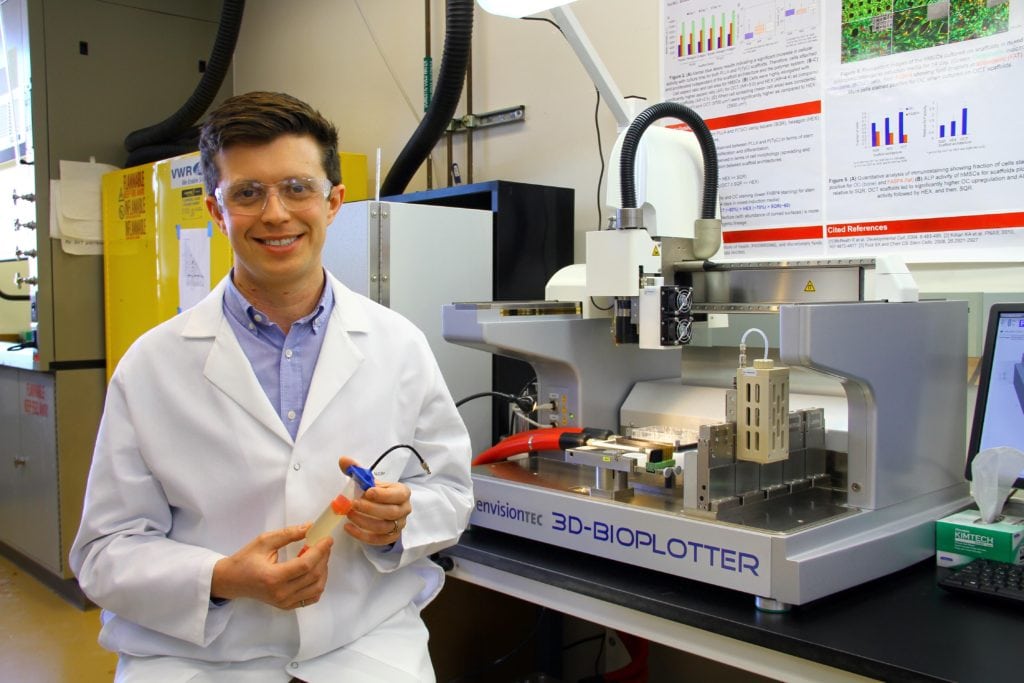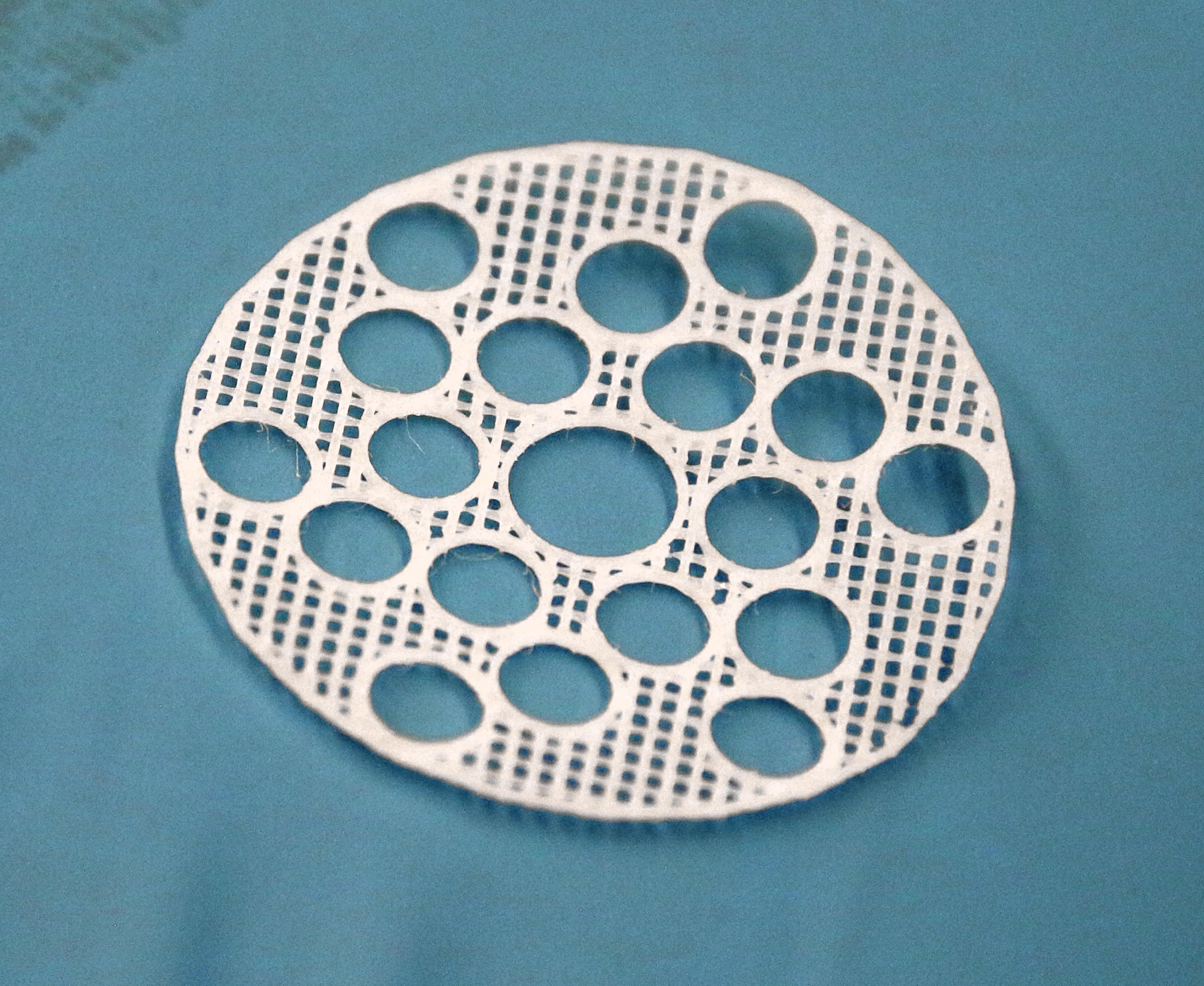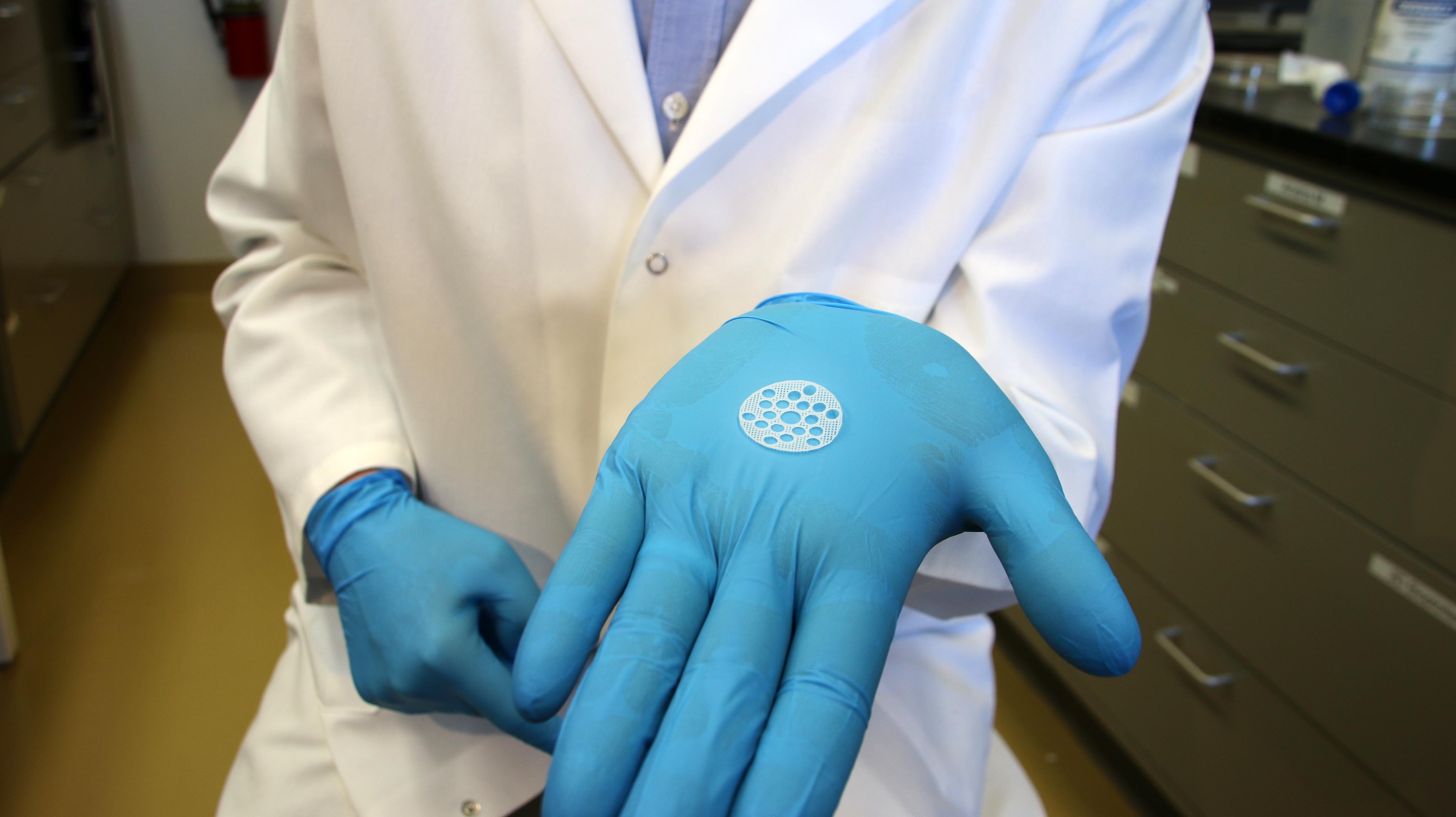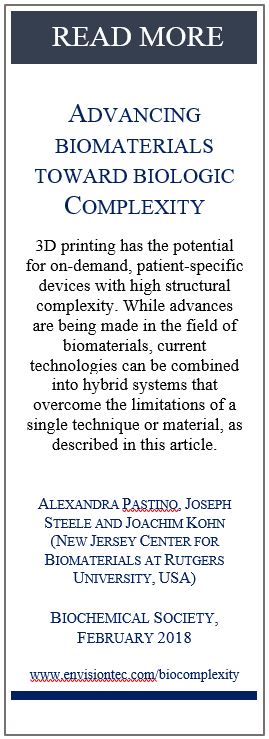
Rutgers Uses EnvisionTEC 3D-Bioplotter for Breakthrough Biomaterials Research
The New Jersey Center for Biomaterials (NJCBM) at Rutgers, the State University of New Jersey, develops advanced biomedical products for tissue regeneration and the delivery of pharmaceutical agents.

Dr. Joachim Kohn, Director of the New Jersey Center for Biomaterials
“State-of-the-art 3D printing technology from EnvisionTEC is a key part of that effort” said Dr. Joachim Kohn, director of the NJCBM. “We regard additive manufacturing as one of the disruptive technologies in the field of biomaterials.
“In particular, the capabilities offered by EnvisionTEC’s 3D-Bioplotter allow us to create prototype implants with unique architecture that couldn’t be made in any other way.”
Eliminating Manual Methods & Advancing Research
Dr. Joseph Steele, a postdoctoral associate working under Dr. Kohn, divides the center’s use of 3D printing into two broad categories:
• Custom devices for testing how human cells interact with specialized bio-polymers they develop, and
• Implants for pre-clinical studies in animals, with the NJCBM exploring, bone, cartilage, tooth, and nerve repair, among other topics.
“For many of our implants, there is no way we could manufacture these items other than by 3D printing,” Steele explained.

A scaffold for meniscus repair was printed on an EnvisionTEC Manufacturer Series 3D-Bioplotter from a custom tyrosine-derived polymer at the Center for Biomaterials at Rutgers, The State University of New Jersey in collaboration with the Orthopaedic Research Laboratory at Rutgers Biomedical and Health Sciences. This 3D printed implant is currently under commercial development by NovoPedics, Inc.
In one case, before 3D printing was employed, implant prototypes were produced by students who were hand weaving polymer fibers. The method was extraordinarily time consuming and labor intensive, but it was the only way to get an open mesh with the right organization and structure.
Transitioning to a 3D printing methodology has made this process much faster and more reproducible. The EnvisionTEC 3D-Bioplotter prints polymer strands that fuse together at their interfaces, resulting in an integrated implantable structure right off the bed of the printer. Then, the part just needs to be sterilized.
Steele added that the center’s 3D-Bioplotter Manufacturer Series machine is uniquely capable of producing these structures.
“Many of the other 3D printers don’t have the necessary control,” Steele said. “Printing the proprietary polymer we’re using for the implant requires high temperature and high pressure to get a very fine filament, which other printers aren’t capable of achieving with the same level of reproducibility. So, not only could we not manufacturer this implant without 3D printing, we couldn’t manufacturer it without this 3D printer.”
Multi Material & Multi-Purpose
The team at the NJCBM also lauded the EnvisionTEC 3D-Bioplotter’s ability to handle multiple materials for a range of applications. “We’re printing something different every day and sometimes need the ability to combine materials within the same structure.”

The EnvisionTEC Manufacturer Series 3D-Bioplotter was used synergistically with polymer airbrushing to create a new class of ‘hierarchical’ implants at the Center for Biomaterials at Rutgers, The State University of New Jersey. The iterative use of 3D printing and microfiber airbrushing provides a complex scaffold with a gradient of properties. To illustrate this capability a scaffold was 3D printed from poly(l-lactic acid) and filled with tyrosine-derived airbrushed microfibers loaded with a red or yellow pigment. Altering the ratio of yellow and red fibers created a gradient of composition.
The 3D-Bioplotter is used at NJCBM for everything from scaffolds for bone and cartilage regeneration to platforms for stem cell biology. Day-to-day use of the machine includes printing with molten polymers—either commercial polymers or the center’s own formulations— at up to 250 degrees Celsius and 9 bar (130 psi) of back pressure with high reproducibility.
NJCBM also 3D prints silicone and hydrogels of chitosan, collagen, gelatin, alginate, poly(ethylene glycol), which can be loaded with live cells. These hydrogels can be printed at the same time as polymer scaffolds, generating multi-material systems. It’s a workhorse machine for the NJCBM and is used for a wide variety of applications.
Steele also explained that there is tremendous variation in the bio-polymers developed by NJCBM’s decades of research in this area. NJCBM has created a wide range of unique bio-polymers derived from tyrosine with different degradation properties ranging from non-degradable all the way to ultra-fast degrading.
The mechanical properties of the polymers also range, with ultra-strong and ultra-tough formulations, making full use of the 3D-Bioplotter’s abilities.
One example Steele highlighted is an implantable brain probe coating, developed to be very stiff for insertion of fine electrodes into the brain, and then ultra-degradable once inserted, exposing the probe within two hours.
High Accuracy & Repeatability Enable Creative Solutions
NJCBM also relies on the extreme accuracy of the EnvisionTEC (1 micron axis resolution and 0.03 mm needle sensor resolution) to combine methods in creative ways.

The EnvisionTEC Manufacturer Series 3D-Bioplotter was used synergistically with electrospinning at the Center for Biomaterials at Rutgers, The State University of New Jersey. Poly(-caprolactone) supports were printed on top of a 50 µm-thick electrospun tyrosine-derived polymer microfiber mat co-spun with poly(ethylene glycol). The resulting custom microwells had thin, porous microfibrous bottoms and robust PCL walls and handles. To aid in handling multiple wells for higher-throughput applications, larger support structures were printed out of PCL, capable of holding and aligning four at a time.
In one example, they electro-spin sub-micron, non-woven fiber mats (using one of their tyrosine derived polymers) and then print directly onto them with a simple PCL to create reinforced hybrid devices.
“We use the EnvisionTEC not only to print the actual scaffolds being implanted or being tested, but also devices that facilitate the research,” said Steele.
Along similar lines, NJCBM has also combined 3D printing and airbrushing in a technique they refer to as hierarchical printing. They produce sub-micron fibrous scaffolds reinforced throughout with 3D printed structures. The mats alone have a low porosity and low strength which can be overcome with 3D reinforcement.
This combination of techniques requires both the accuracy of the EnvisionTEC and the flexibility of the software allowing the printed materials to be removed and replaced dozens of times within a single print, an advantage highlighted by the team at NJCBM.
Ease of Use With a High Level of Control
Steele said the EnvisionTEC is also extremely reliable and easy to use. “For example, I’m very happy to let it run overnight, which I cannot say about any of our other 3D printers.”
“Another thing I really enjoy about this printer is automated calibration. It’s extraordinarily important to calibrate the flow rate, the needle position and printing surface, because a height difference of even 50 microns can be the difference between success and failure. The EnvisionTEC has a built-in height sensor with calibration that runs automatically. Many of the other printers rely on user calibration, which is much slower and much less accurate. EnvisionTEC’s sensor and camera-based automated calibration is another feature which sets it apart.
“I can trust my undergraduates to run this printer, because it’s reliable, the interface is easy, and it has a lot of safeguards built-in against user error. It’s definitely the iPhone of printers. It doesn’t let you break it.”

Gelatin-alginate hydrogels containing live cells printed with a range of porosities and architectures. Precise control over pore geometry leads to reproducible tissue structure and improved cell viability.
But while the 3D-Bioplotter may be reliable and easy to use, it also offers a high degree of control. Steele said you can customize all the printing parameters for each material.
“Even parameters like the manner in which you apply air pressure to a certain polymer, because depending on the visco-elasticity of the molten polymer it might take a fraction of a second to actually start flowing, and when you remove that pressure it might take a fraction of a second to stop flowing. That’s all individually and customizable for every material, which is quite nice.
“EnvisionTEC has an automated program that helps you set these parameters for many polymers. When we develop a new polymer and know very little about how it prints, the machine helps us easily optimize the parameters.”
Steele also explains that many polymers degrade over time, especially at elevated temperatures. So he appreciates the fact that the EnvisionTEC’s technology tracks how long a given sample has been used, and alerts the operator when too much time has passed, giving them the ability to add fresh polymer to the cartridge to complete the job.
“We monitor this closely in our work because we understand that there’s an interplay between degradability and thermal stability and we’re very vigilant about how long our polymers are maintained at elevated temperatures,” Steele said. “The EnvisionTEC software allows us to do this very simply, effectively not letting users accidentally print beyond a designated expiration time.”
EnvisionTEC also offers user-friendly slicing software that imports the STL file, generated from customized CAD designs and/or medical images and prepares them for printing. Steele said that in most cases the object to be printed is first defined in terms of an outer shell. From there the EnvisionTEC software offers easy options for creating a range of infill patterns allowing for the customization of internal structure, stiffness, and porosity between the interior and exterior if desired.
“This high level of control and the ability to combine materials with different properties in complex geometries takes the field one step closer to printing complex tissues,” Steele said.
On the other hand, “if you’re printing a meniscus, instead of just defining a horseshoe shape and using an automated infill, we actually defined every single element to achieve our desired geometry and mechanical properties. If the placement of every element matters, you can define it to that level of detail.”
Teaching 3D Printing to a Growing Workforce
A new initiative at the NJCBM is education and workforce development. Drawing on the rich scientific knowledge of the center and funding support from both state and federal agencies, NJCBM is developing workforce training programs in biofabrication and digital dentistry, both of which involve training in 3D printing and bioprinting.
The simplicity of the software and user-friendliness of the 3D-Bioplotter equipment means that it is an ideal tool to help teach students new to the field, said Dr. Sangya Varma, COO of NJCBM and Chief, Workforce Development Programs at NJCBM.
“My hope is to democratize the education of 3D-biofabrication,” Varma said. “The students are able to see the high-end applications of this competency-based curricula through the EnvisionTEC 3D-Bioplotter.”
TO LEARN MORE ABOUT THE EXCITING WORK BEING DONE AT NEW JERSEY CENTER FOR BIOMATERIALS, VISIT WWW.NJBIOMATERIALS.ORG/
Watch the Video
Custom Biopsy Guide


About New Jersey Center for Biomaterials (NJCBM) at Rutgers University
NJCBM is a Multidisciplinary Center of Excellence for Tissue Engineering, Regenerative Medicine, and Drug Delivery based at Rutgers, The State University of New Jersey – that spans academia, industry and government.
As biomaterials scientists, our goal is to conduct state-of-the-art research in biomaterials science and engineering and to improve health care and the quality of life by developing advanced biomedical products for tissue repair and replacement, and the delivery of pharmaceutical agents. Our advanced research projects with licensing or partnering opportunities are in bone, nerve, drug delivery and X-ray visible medical implants. Our technologies have been translated into pre-clinical and clinical products, including a fully resorbable and x-ray visible coronary stent, an antimicrobial implant for the prevention of pacemaker infections, a surgical mesh for hernia repair, a bone regeneration scaffold and an ocular drug delivery system for the treatment of inflammatory eye disorders.
We have collaborations using additive manufacturing (3D printing), polymer processing, and scale-up of polymer synthesis. Our major facilities include certified class 10,000 (EN/ISO-14644 Class 7 US federal Standard 209) cleanroom. We have a large network of 60+ Industry collaborators and 30+ National and International Institutions. NJCBM also provides educational and workforce training for scientists and students in biomaterials and regenerative medicine and hosts Annual Symposia on Biomaterials Science.
About Rutgers, The State University of New Jersey
Rutgers, The State University of New Jersey, is a leading national research university and the state of New Jersey’s preeminent, comprehensive public institution of higher education. Established in 1766, the university is the eighth oldest higher education institution in the United States. Nearly 69,000 students and 22,000 full- and part-time faculty and staff learn, work, and serve the public at Rutgers locations across New Jersey and around the world. The university belongs to the Big Ten Academic Alliance, comprised of 14 world-class research universities, and is among the top 20 public U.S. universities for total R&D funding. Rutgers University–New Brunswick is the state’s only public institution in the prestigious Association of American Universities.
As the premier public research university in the state, Rutgers is dedicated to teaching that meets the highest standards of excellence, to conducting cutting-edge research that breaks new ground and aids the state’s economy, businesses, and industries, and to providing services, solutions, and clinical care that help individuals and the local, national, and global communities where they live.
About EnvisionTEC
EnvisionTEC is a leading global provider of professional-grade 3D printers and materials. Founded in 2002 with its pioneering commercial DLP printing technology, EnvisionTEC now sells 3D printers based on six distinct technologies that build objects from digital design files. The company’s premium 3D printers serve a variety of medical, professional and industrial markets, and are valued for accuracy, surface quality, functionality and speed. EnvisionTEC’s intellectual property includes more than 140 pending and granted patents. Learn more at EnvisionTEC.com.






